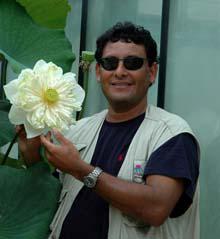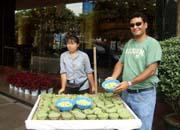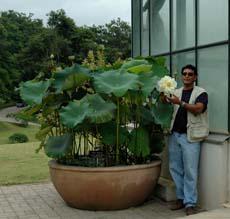|
Costa Rican Approaches Lotus Research and Life with Gusto |
 |
|
|
You probably can’t attribute all of Orozco’s get-up-and-go to the Lotus Project, though. He seems to take on life in general with an intensity and vitality that, were he to bottle it up and sell it, would make him a very wealthy man. So what makes this Costa Rica native tick? If you asked him that question, he might just hand you two single-spaced, 12-point-type pages entitled “The Story of My Life,” by Warner Orozco-Obando. He wrote that 1,200-word piece in 2007, as part of his application -- his successful application, by the way -- for a Horticultural Research Institute scholarship. Anyone who knows Orozco, however, has got to realize there’s
a bit more to his life than the facts he covers in that skeletal
outline -- enough to make for a good, long, interesting read.
|
|
A Man of Many Talents And, when not in school, he has earned a living in Costa Rica as a supervisor of pineapple production research for Del Monte, a professional beekeeper, a community college teacher, a horticulture teacher in a high-school class for mentally and physically challenged students and a natural history/environmental tour guide specializing in tropical plants and crops. Just before coming to Auburn, he worked as a horticulturalist/integrated pest management supervisor with a tree and plant care company in Virginia. At this point, you may be thinking, “OK, just how old is this Warner guy?” Well, he was born in 1964, in Costa Rica, and spent his early years living with his grandparents in a suburb of San José, Costa Rica’s capital. His grandfather, whose family was in education, was born and raised “a city boy”, Orozco says, and thus was perfectly content as a suburbanite. The same could not be said, however, of the grandmother. “Before they moved to the city, she was a farmer and rancher, and after they moved, she dreamed for many years of one day returning to the country,” Orozco says, noting that that never happened. “She lived in the city, but her heart never left the farm.” But you know what they say: You can take the girl out of the country, but you can’t take the country out of the girl. Grandma was determined to stay connected to the land. “She always planted a garden, out in front of the house, with all kinds of vegetables and flowers, and I remember being four or five and helping her, and telling her how I wanted to be a farmer,” Orozco says. “I think it was while I was gardening with her that she sowed the seeds of her passion for plants in me.” |
|
|||||
| Orozco lived with his grandparents until he finished the sixth grade, the last grade of primary school under Costa Rica’s educational system. At that point, students can choose between attending a five-year academic high school or enrolling in a six-year program at technical high school. | ||||||
|
His High School Days The decision was made that Orozco would move to his mother’s home in Puntarenas and attend an academic high school near her. That didn’t last long, though. Orozco detested the academic school’s program, so he moved to the Nicoya Peninsula to live with his father, a regional school superintendent, and enrolled in a nearby technical high school to major in agriculture. “At that school, I went from being a regular ‘passing’ student to an A-plus book lover,” he says. “It’s a beautiful feeling to be studying in a field that you love. Even geometry makes sense when you use it to calculate the area required for your cornfield.” He also had the opportunity to keep his gardening skills honed because his dad had a small nursery behind his house and paid his son an allowance to keep the trees and old-fashioned fruits and vegetables growing in the nursery healthy and thriving. For Orozco, that was a fine way to earn spending money. Orozco’s high marks in high school earned him a scholarship
to the Institute of Technology of Coast Rica, where he chose
to major in agronomy. In his freshman year, he heard about a
US Agency for International Development program through which
young Central American students would go to the United States
to learn the English language and American culture and finish
their undergraduate program. That caught his attention, so he
applied. |
|
Settling in the States He took his first step on American soil in 1988, in Washington, DC. By early winter, he was enrolled in English-as-a-second-language classes at Georgetown University and, in his spare time, applying to undergraduate programs at schools across the country. He got acceptance letters from the University of Hawaii, Tennessee State and UC Davis. “I had to reassess my future career,” Orozco says. “I loved poultry, pigs, vegetables, bees -- I loved everything about agriculture.” He went with the west coast school and vegetable crops and earned his bachelor’s in 1991. The USAID program he’d come to the U.S. under required that he return to Costa Rica for two years. He stayed for 12, and it was in those years that he worked in the aforementioned fields -- as a pineapple researcher, a top-notch Costa Rica environmental tour guide during the dry seasons and a teacher during the rainy, and, of course, as a beekeeper. “I really wanted to be a pig farmer, but I didn’t have the money to get started in that, so I went with bees, even with a lot of old-timers whose hives had been wiped out years earlier by Africanized ‘killer’ bees telling me I was making a big mistake.” But Orozco’s were Africanized hybrid honey bees, which actually were more productive than honey bees common before the African invasion. Soon he had built a steady business, selling honey and wax as fast as he could harvest it. He didn’t make big bucks in the bee business -- the tour guide job was his major source of income -- but it helped pay the bills. And, besides, he enjoyed it. Not far into the new millennium, Orozco left his teaching jobs and began applying for other positions. |
|
Back to School “Every job I applied for, I was either overqualified or not qualified enough,” he says. “So I decided to go back to school.” He applied to universities around the world -- Australia, Japan, Spain, Holland (for a master’s degree in beekeeping!) -- and wound up in Spain, at the University of Andalucía, where he earned an MS in environmental law. Increasingly, though, Orozco was realizing that horticulture was his field, and while in Spain, he had applied for an internship at Marie Selby Botanical Gardens in Sarasota, Florida. On a flight to Sarasota to interview, Orozco spent a night’s layover in Atlanta with some friends he had gotten to know when he served as their tour guide on their Costa Rica vacation. The Georgia Bulldogs fans told Orozco that if he wanted to study ornamental plants, the University of Georgia was the only university to consider applying to. Before his internship at Sarasota, he flew back to Atlanta and with the help and support of his friends headed north for a week on the Georgia campus. Then he returned to Costa Rica to continue his research for his master thesis. In 2002, he got accepted to the horticulture program at UGA. His research to focus on Hortensias (Hydrangea macrophylla). When he earned his master’s in horticulture, he was determined to continue his education “in order to qualify to become a horticulture professor,” he says. Orozco, applied to the doctoral program at Georgia and was told he was shoo-in, but then the wheels stopped turning. “My visa was expiring and the only way to get an extension was if I was in school,” Orozco says. “My professor at Georgia kept telling me to just sit tight, to sit tight, but in the end, the funding never came.” Aware of is situation, he applied to other universities: North Carolina State, Clemson, Florida State and Auburn. After graduation, Warner landed a job as a horticulturist and IPM coordinator with a Virginia-based tree and plant care company. The following year, Auburn’s Tilt talked with him and decided the man would make a great addition to the Lotus Project. Orozco was as good as in, if a lotus research grant Tilt had submitted was funded. |
||
|
It was. And when fall semester 2006 began, Orozco was a doctoral student at Auburn University. He hit the ground running and hasn’t slowed down yet. Tilt says it’s a pleasure to have Orozco as a student and fellow researcher. “As a graduate student, you always hope your work will contribute to society,” Tilt says. “Warner's effort and dedication will definitely make a difference.” Warner admires a Thai lotus cultivar |
||
Read
Is Lotus an Ornamental Plant or a Vegetable?
Yes!
in WGI ONLINE Journal 4.2
and
Auburn Lotus Project: Passionate Plant People
Unite with a Common Vision
in WGI ONLINE Journal 4.3
|
Water Gardening | Water Gardening Friends | New This Month Kit & Ben Knotts | Our Garden | Search The Site | Home Greening the Planet | Email Discussion List | Site Map Water Gardeners International |






